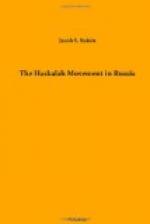Satanov was greatly in favor of expanding the Hebrew language, but the first to borrow expressions from the Talmud literature or coin words of his own was Mendel Levin, also of Satanov, Podolia (1741-1819), the friend of Mendelssohn while in Berlin, the inspirer of Perl and Krochmal while in Brody, the companion of Zeitlin and Schick while in Mohilev. The Meassefim, the name generally applied to all who participated in the publication of the Meassef, were shocked by what they regarded a profanation of the sacred tongue. Their idea was that Hebrew was to be utilized as a means of introducing Western civilization. Afterwards it was to be relegated once more to the holy Ark. To Levin Hebrew had a far higher significance. Not only should Western civilization be introduced into Jewry through its means, but Hebrew itself should be so perfected as to take a place by the side of the more modern and cultivated languages. It should find adequate expressions for the new thoughts and ideas which the new learning would introduce into it directly or indirectly. The medieval translations from the Arabic should be retranslated into the new Hebrew, he held, and he furnished an example by recasting the first part of Maimuni’s Moreh Nebukim. His modernized version, lucid and fluent, printed alongside of Ibn Tibbon’s, presents a striking contrast to the stiffness and obscurity of the Provencal scholar’s. Levin was also the first to write in the Yiddish, or Judeo-German, dialect, for the instruction of the masses, which made him the butt of more than one satire. But what was generally regarded as a degrading task was fraught with the greatest consequences to the Haskalah. To this day Yiddish has continued an important medium for disseminating culture among Russian Jews, both in the Old World and in the New.[37]
The century remarkable among other things for encyclopedia enterprises,—Chambers’ Encyclopedia in England, the Universal Lexicon in Germany, and that wonderful and monumental work, the Encyclopedie in France—saw, before its close, a similar attempt, in miniature, in Hebrew and by a Slavonic Maskil. Whether the Hebrew encyclopedist was influenced by the example of Dr. Tobias Cohn’s Ma’aseh Tobiah mentioned above, or was unconsciously imbued with the prevailing tendency of the times, it is impossible to tell. In any event, he resorted to the same means, and presented the Jewish world with a volume containing a little of every science known, under the innocent name The Book of the Covenant (Sefer ha-Berit, Bruenn, 1797).




